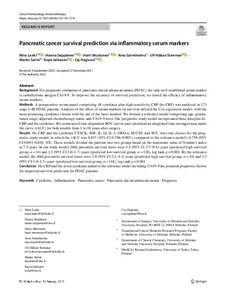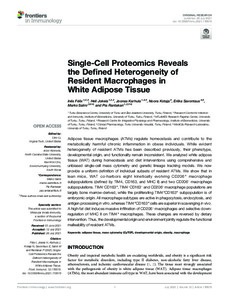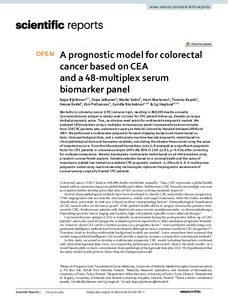Hae
Aineistot 1-10 / 13
Vascular Adhesion Protein-1: A Cell Surface Amine Oxidase in Translation
Significance: Vascular adhesion protein-1 (VAP-1) is an ectoenzyme that oxidates primary amines in a reaction producing also hydrogen peroxide. VAP-1 on the blood vessel endothelium regulates leukocyte extravasation from ...
Vascular Adhesion Protein-1 Determines the Cellular Properties of Endometrial Pericytes
Vascular adhesion protein-1 (VAP-1) is an inflammation-inducible adhesion molecule and a primary amine oxidase involved in immune cell trafficking. Leukocyte extravasation into tissues is mediated by adhesion molecules ...
A plasma metabolite score of three eicosanoids predicts incident type 2 diabetes: a prospective study in three independent cohorts
<p><b>Introduction </b>Peptide markers of inflammation have been associated with the development of type 2 diabetes. The role of upstream, lipid-derived mediators of inflammation such as eicosanoids, remains less clear. ...
CD73 contributes to anti-inflammatory properties of afferent lymphatic endothelial cells in humans and mice
CD73 is an important ectoenzyme responsible for the production of extracellular adenosine. It is involved in regulating inflammatory responses and cell migration and is overexpressed in various cancers. The functions of ...
Pancreatic cancer survival prediction via inflammatory serum markers
<p><strong>Background: </strong>For prognostic evaluation of pancreatic ductal adenocarcinoma (PDAC), the only well-established serum marker is carbohydrate antigen CA19-9. To improve the accuracy of survival prediction, ...
Head and neck squamous cell carcinoma cell lines have an immunomodulatory effect on macrophages independent of hypoxia and toll-like receptor 9
<p><b>Background:</b> A low tissue oxygen level, < 1% O-2, is a typical characteristic inside of solid tumors in head and neck cancer (HNSCC) affecting a wide array of cell populations, such as macrophages. However, the ...
Single-Cell Proteomics Reveals the Defined Heterogeneity of Resident Macrophages in White Adipose Tissue
<p>Adipose tissue macrophages (ATMs) regulate homeostasis and contribute to the metabolically harmful chronic inflammation in obese individuals. While evident heterogeneity of resident ATMs has been described previously, their phenotype, developmental origin, and functionality remain inconsistent. We analyzed white adipose tissue (WAT) during homeostasis and diet interventions using comprehensive and unbiased single-cell mass cytometry and genetic lineage tracking models. We now provide a uniform definition of individual subsets of resident ATMs. We show that in lean mice, WAT co-harbors eight kinetically evolving CD206<sup>+</sup> macrophage subpopulations (defined by TIM4, CD163, and MHC II) and two CD206<sup>-</sup> macrophage subpopulations. TIM4<sup>-</sup>CD163<sup>+</sup>, TIM4<sup>-</sup>CD163<sup>-</sup> and CD206<sup>-</sup> macrophage populations are largely bone marrow-derived, while the proliferating TIM4<sup>+</sup>CD163<sup>+</sup> subpopulation is of embryonic origin. All macrophage subtypes are active in phagocytosis, endocytosis, and antigen processing in vitro, whereas TIM4<sup>+</sup>CD163<sup>+</sup> cells are superior in scavenging in vivo. A high-fat diet induces massive infiltration of CD206<sup>-</sup> macrophages and selective down-regulation of MHC II on TIM4<sup>+</sup> macrophages. These changes are reversed by dietary intervention. Thus, the developmental origin and environment jointly regulate the functional malleability of resident ATMs.<br></p>...
The Role of Inflammatory Cytokines as Intermediates in the Pathway from Increased Adiposity to Disease
<p>Objective <br></p><p>This study aimed to investigate the role of cytokines as intermediates in the pathway from increased adiposity to disease.<br></p><p>Methods <br></p><p>BMI and circulating levels of up to 41 cytokines ...
A prognostic model for colorectal cancer based on CEA and a 48-multiplex serum biomarker panel
Mortality in colorectal cancer (CRC) remains high, resulting in 860,000 deaths annually. Carcinoembryonic antigen is widely used in clinics for CRC patient follow-up, despite carrying a limited prognostic value. Thus, an ...
Effects of altered salt intake and diet on cytokines in humans: A 20-week randomized cross-over intervention study
High sodium concentration alters leukocyte activation, and in particular T-helper (Th) lymphocyte polarization, and drives the development of autoimmune diseases in mouse studies. Similar results have been obtained with ...









